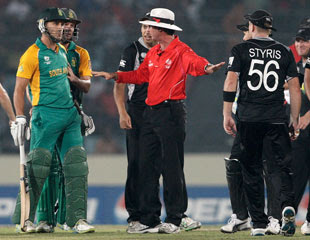Do we pay them the same reverence in cricketing circles? In the male dominated corridors of our great game (thanks, cricketsjk) has the old boys' network shown them the requisite respect?
No longer do we live in the male dominated societies of the 1920s and '30s. A woman's place is not in the kitchen or typing the dictated notes of her male superior - many would say they're on a surge. Why should cricket be any different?
Whilst I grew up enthralled by the deeds of Crowe, Hadlee, Cairns and Jones, and lapped up every snippet of the all-conquering Windies though the 1980s and '90s, there was another less fancied but perennial constant. Debbie Hockley was a cricketing pioneer; a world class batter who dominated the women's game. Through 21 years Hockley dismantled all comers at international level and was part of New Zealand's World Cup winning White Ferns in 2000 - she still holds the record for World Cup runs with 1501. She was a fantastic cricketer - gender is not important.
Lesley Murdoch, a dual New Zealand cricket and hockey international, was one of, if not, the first woman to commentate on men's cricket on our airwaves. She still commentates on a number of first class matches every season and it's a delight to listen to her views on New Zealand Cricket and the issues facing our game. Murdoch has no need to compete with her male peers; she is simply a commentator bringing our summer game to life.
Most of my private life is just that, but I met my wife because of her love of cricket, so women in cricket hold a special place in my heart. One of my work colleagues, a young South African, sums up what I love about women and cricket. Unlike many of my mates who become emotive, and irrational, when discussing players and issues, she tends to consider her response before jumping in with both feet - she is as knowledgeable and passionate as anyone I debate cricket with. She doesn't conform to the negative, and misguided, stereotype that women trivialise players on their physical attributes - the only attributes discussed are how Kallis struggled to complete his action when he bulked up or how Steyn positions his wrist behind the ball for different deliveries. Watching her discount the snide comments of her peers with cricketing knowledge and insight, not cutting personal remarks, is a thing of beauty.
I don't raise these examples to illustrate that the occasional woman has cricketing nous; I do so because they are real examples that gender need not come into our game - women are not islands in the sea.
 |
| Others? Really? They're Women's Internationals |
I'm new to the world of Twitter but have been amazed at the number of women writing, and tweeting, on our great game. These are some of the best - follow them on Twitter and have a read of their blogs:
@FirdoseM – Firdose Moonda is the real deal! She is ESPNCricinfo’s South African correspondent and a guaranteed great read. She doesn’t blog, she writes for a living.
@mspr1nt - Ant Sims is a fantastic South African blogger, and a self-described ‘female cricket disciple’. You can read her thoughts on WicketMaiden, a website that promotes the tagline – balls to the wall and no balls at all. Like me, the Windies hold a special place in her heart – if you’re ever looking for comment, just mention Chris Gayle. For those who like statistics, Ant’s infographics are well worth a look.
@lemayol - an obsessive follower of Northern Districts and the Somerset CCC, she will discuss Kane Williamson at any opportunity, with aplomb. @lemayol has just launched a new cricketing agony aunt column, Miss Cricket, on Alternative Cricket - email her for all the answers to your cricketing dilemmas.
@legsidelizzy – with over 5,000 Twitter followers Lizzy is everywhere cricket is. A freelance writer for both The Mirror (UK) and SPIN cricket magazine, and a guest commentator on Test Match Sofa, Lizzy describes herself as ‘part-time cricket writer. Full-time cricket tragic.’ She offers great insights with an English spin – you can read her thoughts at legsidelizzy.com.
@fayeb07 – a self-professed lover of English cricket, Faye is a more recent convert but her writing shows a cricketing maturity that belies that. Her blog – Caught at Slip, provides her thoughts on the English game including coverage of the England Women.
To the women who have read this, I sincerely hope it hasn't come across as condescending; it's meant as the complete opposite. I love the work of the female scribes - not due to their gender but because I appreciate their writing and views.
Don't get me wrong; I'm sure there are women who do go the cricket to see their white knight, just as some men use it as a chance to get lagered and hurl vitriol at the combatants - sport simply reflects life.
No-one should judge coverage and comment by the gender of the writer but by the quality and insight of the writing. If you don't like a piece, comment and tell the author - we all love feedback. For many of us it's the reason we write, for the interaction with those who love our great game as we all do - woman or man.
If you know of other female scribes, please let me know - make a comment or tweet me @aotearoaxi.






